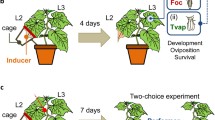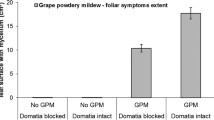Abstract
We have been releasing economically unimportant herbivorous mites of one species early in the season and protecting grapevines against another, more damaging herbivorous mite throughout the growing season. In this experiment, releases of economically unimportant Willamette mites alone, or of predatory mites alone, failed to reduce populations of the damaging Pacific spider mite. However, where both herbivorous Willamette mites and predatory mites were released together populations of Pacific mites were reduced. This interaction between effects of Willamette mites and predatory mites suggests that predation against Pacific mites was more effective where alternate prey (Willamette mites) were available for the predators. The “apparent competition” between Willamette mites and Pacific mites, mediated through their shared predator, can be an important force in the agroecosystem although its importance varies from year to year and vineyard to vineyard.
Similar content being viewed by others
References
Begon M, Harper JL, Townsend CR (1986) Ecology. Individuals, populations, and communities. Sinauer, Sunderland
English-Loeb GM, Karban R (1988) Negative interactions between Willamette mites and Pacific mites: possible management strategies for grapes. Entomol Exp Appl 48:269–274
English-Loeb GM, Flaherty DL, Wilson LT, Barnett WW, Leavitt GM, Settle WH (1986) Pest management affects spider mites in vineyards. Calif. Agric 40:28–30
English-Loeb G, Karban R, Hougen-Eitzman D (1993) Relative importance of direct and indirect competition in mediating negative interactions between spider mites feeding on graphes. Ecol Appl 3:699–707
Flaherty DL, Hoy MA (1971) Biological control of Pacific mites and Willamette mites in San Joaquin Valley vineyards. Part 3. The role of tydeid mites. Res Popul Ecol 13:80–96
Flaherty DL, Huffaker CB (1970) Biological control of Pacific mites and Willamette mites in San Joaquin valley vineyards. Part 1. The role of Metaseilus occidentalis. Hilgardia 40:267–308
Flaherty DL, Christensen LP, Lanini WT, Marois JJ, Phillips PA, Wilson LT (1992) Grape pest management, 2nd edn. University of California, Division of Agriculture and Natural Resources. Oakland
Grosholz ED (1992) Interactions of intraspecific, interspecific, and apparent competition with host-pathogen population dynamics. Ecology 73:507–514
Holt RD (1977) Predation, apparent competition, and the structure of prey communities. Theor Popul Biol 12:197–229
Holt RD (1984) Spatial heterogeneity, indirect interactions, and the coexistence of prey species. Am Nat 124:377–406
Hougan-Eitzman D, Karban R (ms) Mechanisms of interspecific competition that result in successful control of Pacific mites folowing inoculations of Willamette mites on grapevines (in review)
Huang C, Sih A (1990) Experimental studies on behaviorally mediated, indirect interactions through a shared predator. Ecology 71:1515–1522
Jeffries MJ, Lawton JH (1984) Enemy-free space and the structure of ecological communities. Biol J Linn Soc 23:269–286
Karban R, English-Loeb GM (1990) A “vaccination” of Willamette spider mites (Acari: Tetranychidae) to prevent large populations of Pacific spider mites on grapevines. J Econ Entomol 83:2252–2257
Karban R, Myers JH (1989) Induced plant responses to herbivory. Annu Rev Ecol Syst 20:331–348
Morrison DF (1990) Multivariate statistical methods, 3rd edn. McGraw-Hill, New York
Price PW, Westoby M, Rice B (1988) Parasite-mediated competition: some predictions and tests. Am Nat 131:544–555
Quinn JF, Dunham AE (1983) On hypothesis testing in ecology and evolution. Am Nat 122:602–617
Ricklefs RE (1990) Ecology, 3rd edn. Freeman, New York
SAS (1990) SAS User's guide, version 6, 4th edn. SAS Institute, Cary
Schmitt RJ (1987) Indirect interactions between prey: apparent competition, predator aggregation, and habitat segregation. Ecology 68:1887–1897
Settle WH, Wilson LT (1990) Invasion by the variegated leafhopper and biotic interactions: parasitism, competition, and apparent competition. Ecology 71:1461–1470
Tallamy DW, Raupp MJ (1991) Phytochemical induction by herbivores. J Wiley, New York
Author information
Authors and Affiliations
Rights and permissions
About this article
Cite this article
Karban, R., Hougen-Eitzmann, D. & English-Loeb, G. Predator-mediated apparent competition between two herbivores that feed on grapevines. Oecologia 97, 508–511 (1994). https://doi.org/10.1007/BF00325889
Received:
Accepted:
Issue Date:
DOI: https://doi.org/10.1007/BF00325889




